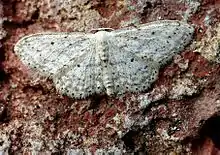Small dusty wave
The small dusty wave (Idaea seriata) is a moth of the family Geometridae first described by Franz von Paula Schrank in 1802. It is found throughout Europe, the Near East, and North Africa. In the British Isles it is common in England and Wales but is only found in the eastern half of Scotland and is absent from Ireland.
| Small dusty wave | |
|---|---|
 | |
| Scientific classification | |
| Kingdom: | Animalia |
| Phylum: | Arthropoda |
| Class: | Insecta |
| Order: | Lepidoptera |
| Family: | Geometridae |
| Genus: | Idaea |
| Species: | I. seriata |
| Binomial name | |
| Idaea seriata (Schrank, 1802) | |
The species is very small (wingspan 19–21 mm) and is probably one of the least striking members of the whole family, being basically grey with all markings indistinct apart from the black discal spot typical of the genus. Either one or two broods are produced each year and the species can be seen on the wing any time from June to September, flying at night and sometimes coming to light.
The larva feeds on ivy and the species overwinters in this form.
- ^ The flight season refers to the British Isles. This may vary in other parts of the range.
Subspecies
- I. s. canteneraria
- I. s. seriata
References
- Chinery, Michael Collins Guide to the Insects of Britain and Western Europe 1986 (Reprinted 1991)
- Skinner, Bernard Colour Identification Guide to Moths of the British Isles 1984
External links
| Wikimedia Commons has media related to Idaea seriata. |
| Wikispecies has information related to Idaea seriata. |
- Small dusty wave at UKMoths
- Fauna Europaea
- Moths and Butterflies of Europe and North Africa
- Lepiforum e.V.